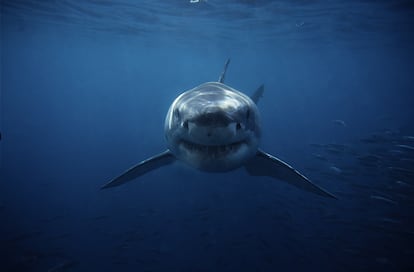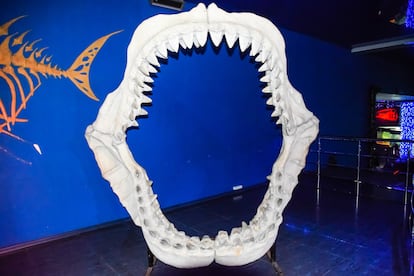The great white shark brought about the extinction of the gigantic megalodon
The presence of a metal in the fossil teeth of both sharks suggests that they competed for the same food, and the smaller animal won

The big fish doesn’t always eat the small fish. Until about three million years ago, the king of the seas was the megalodon (Carcharocles megalodon), an enormous shark up to 20 meters long. But something caused it to go extinct, leaving the crown to the great white shark (Carcharodon carcharias). Some theories blame climate cooling for the extinction. Others point to the decline of whales, the megalodon’s main prey. A third group of scholars points to the appearance of new competitors for resources, such as the first ancestors of killer whales. But analysis of the teeth of large fish from the past and present now raises another possibility: Great white and megalodon sharks competed for the same food, and the former won.
The megalodon was the largest shark that ever lived. Compared to him, the great white, at six meters, is just a minnow. Megalodon teeth were about 10 times larger than great whites’. Those teeth may hold the key to the megalodon’s disappearance. A group of researchers has created a system to discover where both animals were in the food chain, called their trophic level. To find out the species’ place in the ecosystem, they studied the presence and concentration of a zinc isotope in the sharks’ teeth enamel. (Isotopes are variations of the same chemical element, in which the number of neutrons in the atomic nucleus changes.) The researchers focused on the isotope Zn-66, which is so stable that, as explained in the study published in Nature Communications, it remains nearly unchanged after millions of years.
The researchers began by measuring the concentration of zinc in the teeth of almost 30 species of living sharks. They were able to draw a correlation between Zn-66 levels and the species’ position in the food chain. The isotope’s levels depends largely on the animal’s diet, and lower levels indicate a higher spot on the food chain. Then, they returned to the fossil record to study the element’s presence in the teeth of megalodons, their predecessor and other sharks of that time. Among those species were the white shark, which had appeared about three million years before the megalodon went extinct.

The scientists found that concentrations of the isotope depended on the geographical area and the shark studied. But in the waters near what is now the east coast of the United States, where the white shark and the megalodon met, they found similar levels of zinc in both animals. Michael Griffiths, professor at William Paterson University and co-author of the study, explains that “our results show that both the megalodon and its ancestor were at the top of the predators, feeding at the top of their respective food chains.” But what is new is that “zinc isotope values from shark teeth from the early Pliocene [between 5 and 3.5 million years ago] suggest largely overlapping trophic levels of early great white sharks with much larger megalodon.”
DePaul University professor Kenshu Shimada maintains that “these results imply at least a certain degree of overlap in the prey that both species of sharks hunted.” Although he acknowledges that more research is needed, he says that the study supports “the possibility of megalodon dietary competition with early Pliocene great white sharks.”
The thesis that megalodons disappeared because of competition for resources is not new. Robert W. Boessenecker, from the University of California Museum of Paleontology, supports it. In 2019, he published a paper that moved the extinction date of megalodons forward by a million years, which implies that they disappeared before the great extinction of marine animals, in particular cetaceans, 2.6 million years ago. “We proposed that the evolution of the modern great white shark led C. megalodon to extinction through competition for similar prey,” says the researcher, who is not affiliated with the new study.

“The first white sharks evolved in the Pacific Ocean from an ancestor with unserrated teeth. But the evolution of teeth around 6-7 million years ago tells us that they started feeding on warm-blooded marine mammals for the first time, as these teeth are an adaptation to cut through the fat,” explains Boessenecker. “Four million years ago, Carcharodon carcharias first appeared in the North Atlantic and other basins. That dispersal, around 3.5-4 million years ago, coincided with the extinction of C. megalodon all over the world,” he adds.
One of the first people to propose competition for food as a cause was the researcher Catalina Pimiento. Head of a group of researchers from the University of Zurich, Swansea University and the Smithsonian Tropical Research Institute, Pimiento specializes in shark extinction, both in preventing the extinction of existing species and to study those that have vanished. For her, extinction has no single cause. “The extinction of the megalodon has been studied for at least six years. Different studies have suggested several factors, especially the loss of habitat due to fluctuations in sea level, and the consequent reduction in the availability of prey and the possible increase in competition.”
Tu suscripción se está usando en otro dispositivo
¿Quieres añadir otro usuario a tu suscripción?
Si continúas leyendo en este dispositivo, no se podrá leer en el otro.
FlechaTu suscripción se está usando en otro dispositivo y solo puedes acceder a EL PAÍS desde un dispositivo a la vez.
Si quieres compartir tu cuenta, cambia tu suscripción a la modalidad Premium, así podrás añadir otro usuario. Cada uno accederá con su propia cuenta de email, lo que os permitirá personalizar vuestra experiencia en EL PAÍS.
¿Tienes una suscripción de empresa? Accede aquí para contratar más cuentas.
En el caso de no saber quién está usando tu cuenta, te recomendamos cambiar tu contraseña aquí.
Si decides continuar compartiendo tu cuenta, este mensaje se mostrará en tu dispositivo y en el de la otra persona que está usando tu cuenta de forma indefinida, afectando a tu experiencia de lectura. Puedes consultar aquí los términos y condiciones de la suscripción digital.
More information
Últimas noticias
The story of the Málaga virus: The code that haunted Google’s cybersecurity center director for 30 years
The impact of Ecuador’s mega-prison: A polluted river, cleared forests and military checkpoints
Corinne Low: ‘I’m more concerned about the female happiness gap than the gender wage gap’
Trump traveled on Epstein’s plane ‘many more times’ than previously thought, according to new documents
Most viewed
- The low-cost creative revolution: How technology is making art accessible to everyone
- Christian Louboutin: ‘Young people don’t want to be like their parents. And if their parents wear sneakers, they’re going to look for something else’
- All the effects of gentrification in one corner of Mexico’s Colonia Roma
- Liset Menéndez de la Prida, neuroscientist: ‘It’s not normal to constantly seek pleasure; it’s important to be bored, to be calm’
- Christmas loses its festive spirit: ICE fears cast shadow over religious celebrations











































